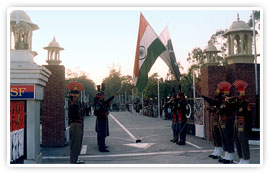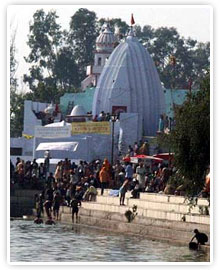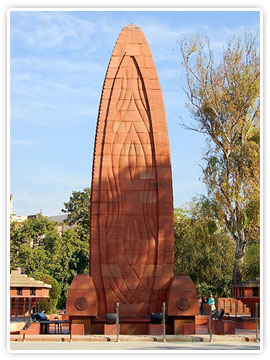Home | About Us | Privacy | Resources | Contact Us

Home | About Us | Privacy | Resources | Contact Us

Amritsar, literally meaning the 'Pool of the Nectar of Immortality', is one of the major cities of the Punjab state. The administrative headquarters of the Amritsar District, it is the major spiritual and cultural centre of Sikhs. The city, founded in 1577 by Guru Ram Das, the fourth Sikh Guru, is mostly inhabited by the Sikhs. Amritsar has grown from a sacred village pool into a spiritual centre of Sikh culture. The original pool site by which the Golden Temple is built was granted by the Mughal Emperor Akbar. In 1761 Ahmad Shah Durrani sacked the town and destroyed the temple, which was rebuilt in 1764. One of the ancient and charming cities of India, Amritsar is an important distribution centre of dry-fruits in the country. Apart from an important pilgrimage centre, the city is also famous for producing some exquiste items like carpets, fabrics, handicrafts etc.
| » Golden Temple | » Jallianwala Bagh |
| » Wagah Border | » Rambagh Garden |
| » Ram Tirath Temple | » Tarn Taran |
| » Mata Temple | » Durgiana Mandir Amritsar |
| » Gobind Garh Fort Amritsar |
 The final frontier, Wagah about 28 kms. from Amritsar is the only border crossing between India and Pakistan. It's an interesting experience especially at sunset when the 'Retreat' ceremony takes place with the BSF on the Indian Side of the Border. The changing of the guards and the ceremonial lowering of the flags ceremony is carried out with great pomp.
The final frontier, Wagah about 28 kms. from Amritsar is the only border crossing between India and Pakistan. It's an interesting experience especially at sunset when the 'Retreat' ceremony takes place with the BSF on the Indian Side of the Border. The changing of the guards and the ceremonial lowering of the flags ceremony is carried out with great pomp.
Wagah Border is located about 28 kms. from Amritsar (border between India and Pakistan)
Wagah, an army outpost on Indo-Pak border - between Amritsar and Lahore, is an elaborate complex of buildings, roads and barriers on both sides. The daily highlight is the evening "Beating the Retreat" ceremony. Soldiers from both countries march in perfect drill, going through the steps of bringing down their respective national flags. As the sun goes down, nationalistic fervour rises and lights are switched on marking the end of the day amidst thunderous applause.
 The Shri Ram Tirath complex is a holy place on the Amritsar-Chogawan road, where Valmiki Maharaj composed Ramayana. The temple site is also the place of birth of Luv and Kush, sons of Lord Rama when Sita spent some time there.
The Shri Ram Tirath complex is a holy place on the Amritsar-Chogawan road, where Valmiki Maharaj composed Ramayana. The temple site is also the place of birth of Luv and Kush, sons of Lord Rama when Sita spent some time there.
On the outskirts of Amritsar is this significant historic birthplace of Lav and Kush. It is the spot where sage Valmiki's ashram stood and this is a sacred place for the Hindus where we get a glimpse of statues illustrating scenes from the Ramayana.
The place gets a special mention in the great Hindu epic "Ramayana". It was here that Sita came after Rama deserted her. It was here that the great saint Maharishi Valmiki gave her shelter and protection. Mata Sita gave birth to twins "Luv"and "Kush" the great sons of Lord Rama. Maharishi Valmiki conducted them to highest levels in education in the realms of religious and social life besides intricacies of warfare
A grand old pious lady developed this Hindu temple situated at Rani ka Bagh, on the lines of holy shrine of Mata Vaishno Devi at Katra (Jammu), the temple draws crowds of devotees from far and near. Festivals are celebrated with great pomp and show. An evening visit to the temple gives an opportunity to the visitors to observe the life styles of Hindu families.
This temple is to the northwest of the railway station. It is notable for a Disneyesque series of grottoes and shrines featuring Hindu deities.
Fort Gobind Garh Amritsar is located in the south-west of the city, has been taken over by the Indian army and is now off limits.Leaving Durgiana on the South West of the city, the road leads straight to Govindgarh Fort. The fort built during 1805-09 stands as a guard of the city. In the past it was under the control of Bhangi Sardar, Maharaja Rajit Singh took over it in 1802. Now it is under the control of Indian army.
 Jallianwala Bagh is located at a stones throw from Golden Temple. It is a witness of the tragedy called Jallianwala Bagh Massacre. As the history goes, during the time of freedom struggle, when Mangal Pandey blew the bugle for commencing the struggle for independence, General Dyer made a law that no Indian will be allowed to hold gatherings or processions.
Jallianwala Bagh is located at a stones throw from Golden Temple. It is a witness of the tragedy called Jallianwala Bagh Massacre. As the history goes, during the time of freedom struggle, when Mangal Pandey blew the bugle for commencing the struggle for independence, General Dyer made a law that no Indian will be allowed to hold gatherings or processions.
On 13 April 1919, Baisakhi Day, thousands of Punjabis gathered from nearby places to celebrate the festival. As the communication system was underdeveloped at that time, they were not informed regarding this law. Thinking it as a violation of the law, General Dyer entered in the Park with his troops and open fired on all the innocent men women and children present there.
Some people were shot dead, some were wounded, and a majority of the people tried to jump in the well to escape the death form the hands of foreign power. There is no accurate record of the number of people died and wounded.
The poet Rabindranath Tagore returned the' Knight hood' conferred to him in protest against the massacre. Dyer was removed and went back to London. Around next March, under the leadership of Gandhiji, non-cooperation movement started throughout the country. Going back to London from Punjab, the then Governor 0' Dyer, while delivering a speech in Caxton Hall (at London) was killed by a Punjabi youth Udham Singh. In memory of those unknown martyrs, a beatiful red sand-stone commemoration dias has been built. The Martyrs Well is still visible in the beautiful garden. The interesting point is that on October 14, 1997 British Queen Elezabeth (2nd) during her visit to India offered flower bouquet here to show her respect to those martyrs. A Martyrs Gallery has been. built with the display of the photographs and letters. In summer it is open from 9-17-00 & in winter from 10-16-00.
Rambag Garden is the posh area of the new city to the N-East of railway station. In the vast area of the garden, there are numberof organisations connected with games and sports. The beauty of the flowers in the garden is pleasant as well. Maharaja Ranjit Singh's former summer palace, in the middle of the Garden is now a museum which is closed on Wednesday. One will find old aristocracy along-with modernity at Rambag. The Mall is also located at Rambag. Interested persons may visit Khalsa College (1892) and Guru Nanak University as well.
It is an important Sikh tank located about 25 kms. south of Amritsar, said to have healing properties and a corrective effect on minor skin ailments. Though the Parikrama around the still waters of the tank takes much longer, it is built along the same lines as the Golden Temple. There's a temple, which was constructed by Ranjit Singh. Fairs are held here on every 'Amavas' dark night of the month This is another gurudwara and tank built in 1768 by Guru Arjun Dev, in the town of Tarn Taran. The holy building commemorates Guru Ram Das (the Sikh guru who founded the city of Amritsar) known to have selflessly slept alongside a leper once. Though there is no scientific evidence that the water cures leprosy, it is said to have healing properties.
A walk away from the complex through the narrow passageways brings the visitors to the 16th century Hindu temple of Durgiana . They are also several other important temples and mosques in the old city . The mosque of Mohammed Jan with its pure white domes and slim minarets is.
In its present form the temple echoes of not the traditional Hindu temple architecture, but that of the Golden Temple. It rises in a similar manner from the midst of a tank and has canopies and a central dome. Its foundation stone was laid by one of the greatest reformers and political leaders of resurgent India, Pandit Madan Mohan Malviya. It is a well-known repository of Hindu scriptures.
Also called the Lakshmi Narayan Temple, it is dedicated to goddess Durga and a large part of the temple is also dedicated to Hindu deities Laxmi, The Goddess of wealth and Narayan, The Preserver of Universe. All dignitaries visiting Golden Temple make it a point to visit Durgiana Temple also.